.
The Brochure Series
OF ARCHITECTURAL ILLUSTRATION.
| Vol. I. | MARCH, 1895. | No. 3. |
THE CLOISTER AT MONREALE, NEAR PALERMO, SICILY.
The island of Sicily, being in form nearly an equilateral triangle, with one side facing towards Italy, another towards Greece, and the third, towards Africa, was a tempting field for conquest to the various nations surrounding it. It was successively overrun by the Greeks, Carthaginians, and Romans, and later, after the Christian era, again successively by the Byzantines, the Moors, and the Normans. Almost all of the architectural remains of the older periods belong to the time of the Greeks, as neither the Carthaginians nor Romans left much to show for their occupation of the island. With the exception of occasional ruined examples surviving from the time of the Dorian Greeks who colonized Sicily, most of the monuments now existing belong to the Byzantine, Saracenic, and Romanesque periods. As would be natural to expect, the latter influences are not clearly separable one from another either in time or in locality. They overlap in all directions; but in general the Byzantine, which was the earliest and most powerful element, is found more strongly marked, and more frequently on the east coast. It however forms the groundwork and is the main ingredient of all that follows. The Saracenic work, which succeeds the Byzantine in date, found a stronger foothold in the South, on the coast nearest Africa; and the influence of the Normans appears in the North.
Every new race of masters in this frequent recurrence of conquest found the island already occupied by a very numerous population of extremely various origin. The newcomers could do no more than add their own forms to those previously in use; the consequence being in every case a mixed style, containing elements derived from every portion of the inhabitants.
Palermo, being on the northern coast, has felt the Norman influence strongly. Its architecture is principally Romanesque in form, with a generous admixture of Byzantine and Saracenic motives in detail and decoration. Exuberance of detail and wealth of color are the rule.
Under the Norman conquerors the Sicilians built as they were directed. Their arts and their civilization were superior to those of their masters, and the Normans were apparently willing to make use of this superiority, and merely adapted the forms of decoration and methods of construction which they found here in use to their own needs and purposes. The polychromatic decoration of the buildings of this neighborhood, such as the interiors of the Capella Palatina and the cathedral at Monreale, ranks among the most successful, if it be not the most successful, work of its class now in existence. It is thoroughly Oriental in character, although applied to buildings intended for Roman ritual. On account of the great superiority of the Moors in art and civilization, not[37] only to the Normans but to all the other inhabitants at the time of the Norman conquest, in the eleventh century, many of the buildings of this period show very little Norman influence. In fact the Oriental character is so extreme in some instances, such as the church of San Giovanni degli Eremiti, that there is very little to suggest that it was Norman and intended for Norman uses.
The village of Monreale is situated on the steep mountain-side about five miles to the west of and overlooking the city of Palermo. The cathedral and the cloister-adjoining it on the south were both parts of a Benedictine convent, which is now mostly in ruins. They were erected by King William the Second, between the years 1174 and 1182, and richly endowed by him. The plan of the cathedral is that of a basilica.
The famous cloister, with coupled columns and clusters of four in the corners, and with a charming fountain and a separate little square of cloisters around it, as it were, in one corner of the open space, is one of the most interesting relics of Palermo. In arrangement it follows the style universal in the countries bordering on the Mediterranean, that is, consisting of a pointed arcade supported by small but elegant columns of Corinthian design, grouped in pairs; while in the North, in England, France, and Germany, a cloister is formed of a series of unglazed windows.
The columns surrounding the fountain, which unfortunately cannot be seen in the general view given in Plate XX., show the richest decoration. The shafts are either plain, rusticated, or covered with patterns executed in relief or mosaic.
There appears to be some doubt as to the date of this work, as the columns have evidently been inserted since the arches which spring from them were built. The discrepancy will be seen in Plates XVIII., XIX., and XX. The disproportion of the dainty columns and capitals to the heavy arches which are entirely in keeping with the architecture of the rest of the cathedral, but which manifestly do not fit the columns, leads to the conclusion that the columns were a later addition, although probably inserted soon after the other work was completed.
XVII.
CAPITALS FROM THE CLOISTER OF MONREALE, SICILY.
The hybrid character of this work will be perfectly evident at a glance. It plainly belongs to none of the styles of the North, but nevertheless has a distinct character and unmistakable charm. The use of mosaic originally placed in the channels of the shafts added greatly to the decorative effect and airiness of these columns.
XVIII.
CAPITALS FROM THE CLOISTER OF MONREALE, SICILY.
A common device in most of the Romanesque cloisters for adding interest to the long colonnade was the grouping of two columns of dissimilar design. This plan is followed here in treating the mosaic inlay vertically in one and horizontally in the other.
XIX.
CAPITALS FROM THE CLOISTER OF MONREALE, SICILY.
The design of the capitals shown in this plate follows the Corinthian model very closely.
XX.
THE CLOISTER OF MONREALE, SICILY.
In a later number of THE BROCHURE SERIES another view of this most charming building will be given. The portion surrounding the fountain, with its groups of four clustered columns, is, in many respects, the most beautiful portion of the structure This will be taken up later.
Ravenna Capitals.
With the reign of Constantine, and the introduction of Christianity as the acknowledged religion of Rome, Byzantine art, as such, made its appearance. The culture of Rome was transferred to Byzantium, henceforth to be known as Constantinople. Governed alternately by Greek and by Persian, it had received a strong Oriental character from the Eastern nations, and had added to the Greek subtlety and delicacy of expression the Oriental love of detail. When converted by Constantine into New Rome, it became a perfect treasure house of Eastern and Grecian art. The Byzantine work, which spread over the East in the sixth, seventh, and eighth[39] centuries, is therefore a union of the refinement of the Greek, the desire for color and detail of the Oriental, and the vigor of constructional invention and conception of mass and grandeur of the Roman. A portion of it was transplanted to Ravenna during Justinian's reign, and there is a glorious afterglow in the Venetian splendor of the tenth and eleventh centuries. The three great centres of Byzantine art work are Constantinople, Ravenna, and Venice; and the three most noted examples, the churches of Sta. Sophia, S. Vitale, and St. Mark's. Apart from these, the cathedral at Monreale, and the Capella Palatina in Palermo, Sicily, represent a variation from the Byzantine type affected by Moslem design.
From the time of Constantine to that of Justinian, one hundred and fifty years, is a period of formation. Under the reign of Justinian, Byzantine art reached its height. Prominent among its factors is the use of mosaic, the influence of which spread insidiously through its whole system, until in the later work the cornices and entablatures of classic design withered into long thin lines of moulding; projections which disturbed the effect of color by the shadows they cast were discarded; voussoirs disappeared under a mosaic veil; surfaces resolved themselves into broad expanses of infinitely varied tones, bounded by narrow but strongly contrasting bands and borders of marble. All ornament had resolved itself into surface decoration, or as nearly that as possible.
In 539 Belisarius took Ravenna in the name of the Emperor Justinian, and to celebrate this event Justinian decided to erect a magnificent monument in the city. He chose to replace, by a more important structure, the small church dedicated to S. Vitale, and built by Néon in the reign of Theodoric.
The wonderful basilica of Sta. Sophia at Constantinople was just completed, and the novelty of its plan and immense effect Produced by its dome, a method of construction entirely novel in Roman architecture, doubtless excited the admiration of the Emperor and led to the adoption of a similar plan for S. Vitale. S. Vitale 18 by no means a copy of Sta. Sophia, but unquestionably was strongly influenced by it.
It was founded in 540, and consecrated in 547. It is octagonal in plan, with an inner structure of eight large piers, arranged in a circle, connected by arches which support a pendentive dome. Following the custom then in vogue, its interior is incrusted throughout with elaborate mosaics in a wealth of color. The most elaborate design and richest color is used in the apse, which was the centre of display in all Byzantine churches.
XXI.
CAPITAL FROM THE APSE OF THE CHURCH OF S. VITALE, RAVENNA, ITALY.
This is one of the most beautiful and most characteristic capitals of the Byzantine style. Its form and decoration are both typical of the style. The flat treatment of the interlace of the vine motive is very generally used, and can be seen in great variety in S. Vitale and elsewhere. The ornament is here enriched with gold and color. In the double capitals of Ravenna the upper member, or cushion, is usually ornamented with symbolic designs drawn from various sources, both Pagan and Christian.
XXII.
CAPITAL FROM THE CHURCH OF S. VITALE, RAVENNA, ITALY.
Here again is the rhomboidal double capital of a much more severe design than that of the preceding plate, but with a remarkable delicacy and refinement of treatment.
XXIII.
CAPITAL FROM THE CHURCH OF S. VITALE, RAVENNA, ITALY.
This is a mean between the two extreme types shown in Plates XXI. and XXII.
In all these examples the treatment of the angles should be noted. Strong confining lines, with a distinct upward tendency of the ornament, contrasted with the flat sides, contribute much to the good effect of these capitals as constructive members.
XXIV.
CAPITAL IN THE MUSEUM OF THE ACCADEMIA DI BELLE ARTI, RAVENNA, ITALY.
Whether this capital was originally intended for S. Vitale or some of the other churches of Ravenna we cannot state, but at all events it is a fitting companion for the others illustrated in this number.
The Brochure Series
of Architectural Illustration.
PUBLISHED MONTHLY BY
BATES & GUILD,
6 BEACON STREET, BOSTON, MASS.
| Subscription Rates per year | 50 cents, in advance. |
| Special Club Rate for five subscriptions | $2.00. |
| Entered at the Boston Post Office as Second-class Matter. | |
An illustrated catalogue has come to be one of the important features of exhibitions of architectural drawings, and these catalogues are now exceedingly valuable records of recent progress in architecture. The contributions of the present year to this department of an architect's library are especially notable. Of the catalogues which have come to our notice, that of the architectural exhibition at the Academy of Fine Arts in Philadelphia is in point of illustration the most complete, and shows the most judicious selection of material. In this there was a marked endeavor to give as large a number of geometrical drawings as possible, and it is unquestionably a move in the right direction. The desire for the picturesque, which has been until recently the ruling motive with American architects, has had its day, and trained and conservative designers have gradually taken the place of the pyrotechnic draughtsman of the past. The change has been working gradually to be sure, but scale and detail drawings both in the exhibitions, which of necessity are intended to appeal to a more or less popular taste, and in the professional journals are from year to year growing more prominent. In their recognition of this tendency, the Philadelphia catalogue committee are to be highly commended.
The same trend may be observed in a little less marked degree in the Architectural League catalogue. The exhibitions of the League have for years been the models by which minor exhibitions have been ruled, and its catalogue has been a guide to all others. As usual there is a great deal of valuable and interesting material presented in its illustrations.
The Catalogue Committee of the St. Louis exhibition have made a departure from the general rule, and increased the size of their pages, allowing the use of much larger plates. In some of the drawings this is a distinct advantage, and their catalogue gains in consequence.
The Boston Society of Architects and the Boston Architectural Club will hold a joint exhibition in April, and their catalogue now promises to be a very creditable publication.
In the recent draughtsmen's competitions, Boston has been more than ordinarily fortunate. The medal in both the competitions of the Society of Beaux-Arts Architects has come to Mr. F. M. Mann, of the Massachusetts Institute of Technology, and a number of the first and second mentions have also come to Boston. In fact, nearly if not quite all the designs sent from Boston have received some recognition at the hands of the jury.
A complimentary dinner has been arranged for by the M. I. T. Architectural Society in honor of the winners of the last competition.
The annual competition for the Architectural League gold medal, which was awarded to Mr. A. H. Wright, also resulted in adding another victory to the credit of Boston draughtsmen.
Interest in these contests is not purely local, however, for Philadelphia, Rochester, and several other cities have furnished contributors and shared the honors. Mr. H. L. Duhring, Jr., of Philadelphia, was awarded the Architectural League silver medal.
Fulfilling the bequest of the late Arthur Rotch leaving $5,000 to the Boston Architectural Club, this sum has been paid to the treasurer of the club by the executors of Mr. Rotch's estate. The income only is to be expended in the purchase of books to form an architectural library. This is only one of many indications that the architectural clubs of the country are recognized as permanent and established institutions. With the spread of this feeling their influence will grow in importance, and as the working foundation of the profession they deserve all the encouragement that can be given them.
The Cleveland Architectural Club.
There are none of the now numerous architectural associations of the country which can more deservingly congratulate themselves upon the early success of their first few months of existence than the Cleveland Architectural Club, which was organized on the 22d of last November, and is now only four months old.
Its original members, fifteen in number, met in the office of Messrs. Coburn & Barnum, and here the meetings for the few succeeding weeks were also held.
It soon became evident that a wide field of usefulness was open to the new organization, and a permanent location of its own would become necessary. Such a location in the heart of the city, with all necessary conveniences, was found in the Garfield Building, and the new rooms have been properly fitted up for the use of the club.
With the purpose of making the influence of its work as far-reaching as possible, the restriction which has commonly been applied in other similar clubs, limiting the membership to architects and draughtsmen, or at least limiting the number of non professional members, has been entirely done away with, and any one who may have an interest in architecture or the "allied arts" is eligible for membership. What will be the effect of this arrangement it remains for the future to decide. In some of the older clubs it has been found by experience that the professional membership was overbalanced and its work impeded by a too large non-professional element, and the professional lines have been closely drawn in consequence.
The work thus far entered upon is modest but of an important character, and if pursued with the earnest purpose which has marked the first few months will lead to a fruitful future.
Of the monthly competitions in design the one for March, the subject of which is a scheme for the public buildings of Cleveland, has attracted considerable attention, and the public exhibition of the designs will doubtless lead to profitable discussion outside the club. A plan which we believe has not been adopted here, but which has been the means of awakening considerable interest in the study of design in the clubs of New York, Philadelphia, and Boston, might possibly be followed to advantage. In the January number of The Brochure Series the competitions instituted by the Society of Beaux-Arts Architects were outlined. Of course with all the numberless calls upon his time, the average draughtsman does not have the leisure to properly study and render the drawings required in these competitions; but by the joining of forces four or five, or even more, men can easily work out such a problem, and in some respects the advantages to be gained are greater than is the case when an individual works alone. Several large tables can be provided in the club-rooms, and the problem worked up as a club design. This plan has been followed in the Boston Architectural Club with great success.
The study of academic design is of the utmost importance to the young architect, and unfortunately the opportunities for such study in the usual routine of office practice are not very extensive. The working out each season of two or three such designs as those required by the Beaux-Arts Society will be of material benefit to the older men who are already familiar with the academic methods of design, and of much more benefit to the younger men whose opportunities have been more limited. The criticism and suggestion of the older men in the profession is easily obtained while the work is in progress. Nothing could be better calculated to foster a certain esprit de corps, which is certainly a desirable quality in any club.
The personnel of the Cleveland Club is as follows: Benj. S. Hubbell, president; Harry S. Nelson, vice-president; Herbert B. Briggs, secretary; Perley H. Griffin, librarian; E. E. Noble, treasurer; W. D. Benes and Wilbur M. Hall, members of the executive board. The officers and Robert Allen, Frederick Baird, J. W. Russell, G. B. Bohm, Williard Hirsh, Ray Rice, Albert E. Skeel, and C. S. Schneider constitute the charter membership.
Books.
Church of Sancta Sophia, Constantinople: A Study of Byzantine Building. By W. R. Lethaby and Harold Swainson. Macmillan & Co. 1894. 307 pages with illustrations. $6.50.
It seems especially fitting that a notice of Mr. Lethaby's work on the church of Sta. Sophia, or as he calls it Sancta Sophia, should appear in the same issue with the beautiful Byzantine capitals from Ravenna, which we publish this month. In the description of this work from Ravenna, on another page, the connection is pointed out between Constantinople, the capital of the Roman Empire in the East, and Ravenna, then the Western capital.
The work before us is an important and exhaustive study, both architecturally and historically, of this beautiful building, which Mr. Van Brunt has called "the central building of the world." Nothing has ever been done in enriching interiors which approaches in splendor the best work of the Byzantine builders, and Sta. Sophia, by general consent, is the most beautiful of the Byzantine churches; but its exterior is by no means without faults, and its claim for distinction would fall if supported only by this.
The book takes up in order the history of Sta. Sophia, with citations of various authorities for statements concerning its early history; accounts of the various vicissitudes through which it has passed; its construction, lighting, details, mosaics, etc., all carefully and conscientiously described, the descriptive portion based on a painstaking study of the building itself. The illustrations which accompany the text are numerous and excellent; there is no attempt to furnish illustrations at large scale, which are already accessible in Salzenberg.
The monumental work of Salzenberg, which has been the architect's reference book for Sta. Sophia, is referred to and largely quoted from.
The two articles by Mr. Henry Van Brunt and Prof. A. D. F. Hamlin, published in The Architectural Review, Vol. II., No. 5, and Vol. III., No. 2, will be found of considerable interest in connection with Mr. Lethaby's book.
Club Notes.
When in our January issue it was announced that we should devote a certain amount of space and attention to the architectural clubs of the country, we had no idea of the extent to which these organizations had developed within the last year or two. The work of a few of the older clubs was familiar to us, but it is a surprise to find that nearly every city of importance in the United States has an active and flourishing society of draughtsmen and young architects. It may be well to suggest right here that any city which has not such an organization should look to its laurels.
Among the newer accessions to the ranks is the Baltimore Architectural Club. It is fortunate in being able to start with a strong, if limited membership. It is holding weekly meetings, and has already instituted a series of monthly competitions in design, for which a small cash prize is offered.
The list of officers is the best evidence of its seriousness of purpose and ability to accomplish an unlimited amount of good work.
The officers are: president, J. E. Sperry; vice-president, J. B. N. Wyatt; secretary, Louis E. Simon; and E. F. Baldwin, George Worthington, J. W. Case, and W. G. Keimig, together with the officers, constitute the Board of Control.
The Sketch Club of New York is following the lead of the Chicago Architectural Club in delegating to one or two of its members the office of Entertainment Committee for one evening, when these members act as hosts and provide for the entertainment of the club. This plan has resulted in an increased attendance at the meetings, and is giving general satisfaction.
An outgrowth of the Boston Architectural Club which has shown a great deal of vitality and in many ways justified its claim to a separate existence is the little club of twelve members known as the "P. D's." Without organization and with only the mutual desire for a sort of Bohemian companionship, these congenial spirits have worked together and amused each other for the last two years.
[47] They are all members of the Architectural Club and among its most zealous supporters.
The mystic monogram of the club, the initials P and D contained in a circle, which was placed on their designs submitted in the two Beaux-Arts competitions, has probably set more than one interested person guessing its significance. Its primary meaning is said to be "Poor Draughtsmen."
Preceding the last regular meeting of the Philadelphia T Square Club an informal supper was held at "Bohemia," a charming rathsheller recently designed by Wilson Eyre, Jr., a member of the executive committee of the club. The president, Walter Cope, presided, while the fifty-four members present lubricated their supper with 158 steins of old musty ale.
The meeting which followed was of unusual interest, as the double programme brought forth a great many designs.
In the competition for a chapel located on the terrace of a wealthy gentleman's country house, Albert Kelsey, who submitted two sets of drawings, was fortunate enough to win both first and second mentions, while E. S. Powers was voted third place.
The competition for a pedestal for a monument was well contested, but the winner of the first place failed to claim his design. Mr. A. C. Munoz, a former winner of the McKim Travelling Scholarship, won second place; and Chas. Z. Klauder, third.
To the list of Architectural Clubs contained in our February issue should be added the following:—
Baltimore Architectural Club; secretary, Louis E. Simon, Builders' Exchange Building.
Cincinnati Architectural Club; secretary, John E. Zettel, 227 Main St.
Society of Beaux-Arts Architects.
The Committee on Education proposes as the subject for its third competition.
A LARGE CITY CHURCH
for an Episcopal parish.
The wealth of the congregation has been lavished upon this building to give it a special character of devotion and beauty, to which the richness of material and the sedate spirit of its classic architecture alike contribute.
In addition to the vast body of the church, which is to be so arranged as to give an impression of amplitude and splendor, provision should be made for vestry, sacristy, and choir-room, conveniently situated for the service of the sanctuary. Two small chapels for the celebration of minor services will be situated so as to be accessible both from the exterior and from the interior of the church proper.
The plot of ground secured for the building is rectangular, and measures two hundred feet by four hundred feet, open to streets on all sides.
Sketches of plan, elevation, and section, at a scale of one thirty-second inch to the foot, will be required of all students wishing to compete; these sketches should be made on opaque drawing paper, not tracing paper, and forwarded not later than 22d April, 1895, to Mr. John E. Howe, 140 West 34th Street, New York City.
For the finished drawings the plan will be rendered at a scale of one sixteenth inch to the foot, the elevation and section at twice that scale, and a detail at a quarter of the size of execution. The finished drawings should in every case be mounted on stretchers. The address to which they are to be forwarded will be announced later. All drawings must be sent on or before 24th June, 1895.
(Signed) Ernest Flagg, Chairman,
John M. Carrere,
John G. Howard,
Thomas Hastings,
Whitney Warren,
John E. Howe, Secretary, Committee on Education.
This competition is open to all students of architecture. Conditions of judgment and jury to be arranged by the committee.
1st April, 1895.

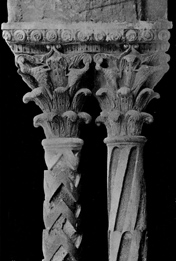 XVII. Capitals from the Cloister of Monreale, Sicily.
XVII. Capitals from the Cloister of Monreale, Sicily. 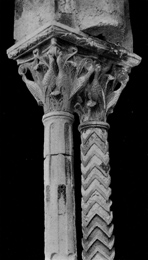 XVIII. Capitals from the Cloister of Monreale, Sicily.
XVIII. Capitals from the Cloister of Monreale, Sicily. 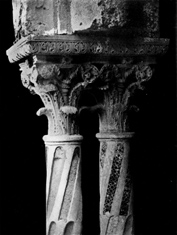 XIX. Capitals from the Cloister of Monreale, Sicily.
XIX. Capitals from the Cloister of Monreale, Sicily. 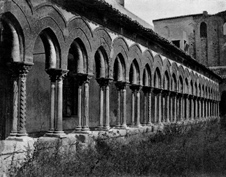 XX. The Cloister of Monreale, Sicily.
XX. The Cloister of Monreale, Sicily. 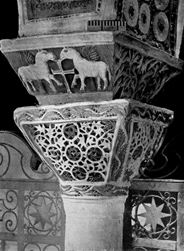 XXI. Capital from the Apse of the Church of S. Vitale, Ravenna, Italy.
XXI. Capital from the Apse of the Church of S. Vitale, Ravenna, Italy. 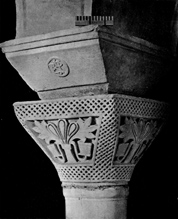 XXII. Capital from the Church of S. Vitale, Ravenna, Italy.
XXII. Capital from the Church of S. Vitale, Ravenna, Italy. 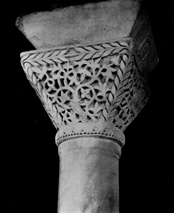 XXIII. Capital from the Church of S. Vitale, Ravenna, Italy.
XXIII. Capital from the Church of S. Vitale, Ravenna, Italy. 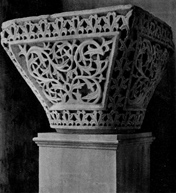 XXIV. Capital in the Museum of the Accademia di Belle Arti, Ravenna, Italy.
XXIV. Capital in the Museum of the Accademia di Belle Arti, Ravenna, Italy. 